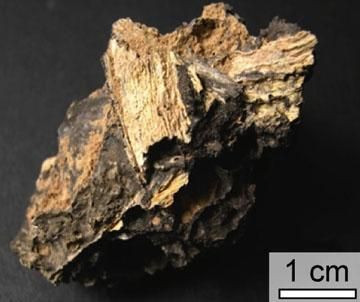Ancient Asteroid ‘Glassy Globs’ Contain Plant Life ‘Trapped Inside’ For Millions Of Years [PHOTO]

Broken glass may provide clues on life on earth millions of years ago.
Ancient fragments of plant life encapsulated in molten glass formed by asteroids were discovered by scientists exploring fields of impact glass in Argentina. Researchers from Brown University, in Providence, R.I., say the fragments come from one of several ancient impacts in Argentina, between 6,000 and 9 million years ago. The findings were published in the current issue of Geology magazine.
“We know these were major impacts because of the shocked minerals trapped inside with plant materials,” Pete Schultz, a geologist from Brown University that led the research effort, said in a statement. “These glasses are present in different layers of sediment throughout an area about the size of Texas.”
The research team discovered bits of leaves and organic compounds preserved in pulverized glass. The findings may shed light on the environmental conditions at the time of impact and may also be a good starting point to find signs of ancient life on Mars.
The impact glass in the recent study comes from the Pampas of Argentina, a glass field where at least seven different impacts occurred. One that took place 3 million years ago may be responsible for the disappearance of 35 animal genera.
Using lab experiments, researchers found the plant material remained intact when hot material captures vegetation and heats it above 2,700 degrees Fahrenheit. Schultz says when a space object hits the ground, it heats sediment on the ground. The resulting globs of melted material roll and pick up material that eventually become encapsulated as it cools off.
In Argentina, the sediment is called loess and has existed for the past 12 million years.
"In North America, the slate was wiped clean," Schultz said. "The glaciers eroded them, so we only see a fraction of the real evidence. But in South America it's all preserved, so the impacts send out these glassy globs that get trapped ... because stuff keeps coming in on top."
The plant life was able to withstand the heat partially due to its makeup.
"It turns out the composition of the plant material is very similar to the composition of the impact glass itself,” Schultz told the BBC. “It was very rapidly transferred from one thing to the other, likely due to the rapid and high heat that boiled off that plant material and replaced it with glass."
The fragments found contain papillae, tiny bumps that line leaf surfaces. The structures were similar to modern pampas grass found in modern-day Argentina. The fact they were preserved for millions of years may mean something similar exists on Mars since the surface material is similar.
“Impact glass may be where the 4 billion-year-old signs of life are hiding,” Schultz said. “On Mars they’re probably not going to come out screaming in the form of a plant, but we may find traces of organic compounds, which would be really exciting.”
© Copyright IBTimes 2024. All rights reserved.






















